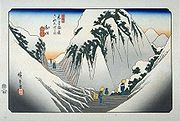
Wada-shuku
Encyclopedia

69 Stations of the Nakasendo
The are the rest areas along the Nakasendō, which ran from Nihonbashi in Edo to Sanjō Ōhashi in Kyoto. The route stretched approximately and was an alternate trade route to the Tōkaidō.-Stations of the Nakasendō:...
of the Nakasendō
Nakasendo
The , also called the , was one of the five routes of the Edo period, and one of the two that connected Edo to Kyoto in Japan. There were 69 stations between Edo and Kyoto, crossing through Musashi, Kōzuke, Shinano, Mino and Ōmi provinces...
. Its present-day location is in the Wada section of the town of Nagawa
Nagawa, Nagano
is a town located in Chiisagata District, Nagano Prefecture, Japan.The town was founded on October 1, 2005 when the town of Nagato and the village of Wada from Chiisagata District merged....
, in the Chiisagata District
Chiisagata District, Nagano
Chiisagata is a district located in Nagano Prefecture, Japan.As of February 1, 2006, the district has an estimated population of 12,039...
of Nagano Prefecture
Nagano Prefecture
is a prefecture of Japan located in the Chūbu region of the island of Honshū. The capital is the city of Nagano.- History :Nagano was formerly known as the province of Shinano...
, Japan
Japan
Japan is an island nation in East Asia. Located in the Pacific Ocean, it lies to the east of the Sea of Japan, China, North Korea, South Korea and Russia, stretching from the Sea of Okhotsk in the north to the East China Sea and Taiwan in the south...
.
History
Located at an elevation of 820 m (2,690 ft), at the entrance to the Wada Pass, it was considered a quiet mountain town. Because Shimosuwa-juku, the next post town, was over 20 km (12 mi) away, it flourished with over 150 buildings to accommodate all of the travelers and their pack animals.Presently, there are remains of both the honjin
Honjin
thumb|250px|The honjin at [[Inaba Kaidō]]'s [[Ōhara-shuku]]. is the Japanese word for an inn for government officials, generally located in post stations during the later part of the Edo period.-Evolution of Honjin:...
and original houses, which are being restored and preserved. The area has also long been known for its vast resources of obsidian
Obsidian
Obsidian is a naturally occurring volcanic glass formed as an extrusive igneous rock.It is produced when felsic lava extruded from a volcano cools rapidly with minimum crystal growth...
.

